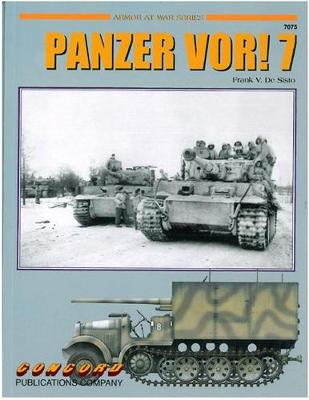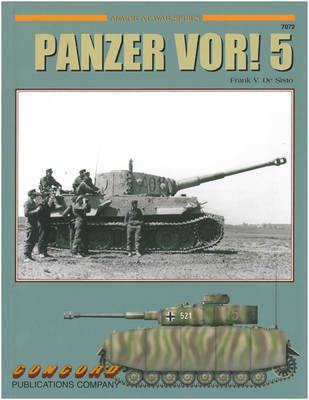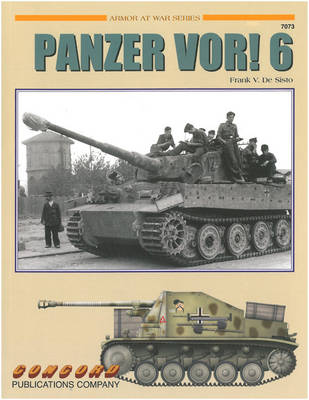Concord - Armor at War
3 total works
The book opens with a precis of the Germany tank industry before and during the war. This summary describes how the nation's arms industry was resurrected in the 1920-30s, and how it sought to provide the materiel and vehicles needed to feed Germany's insatiable war machine. Despite many restrictions and hurdles, German industry did surprisingly well in producing such a wide range of armored fighting vehicles up till the end of the war. These efforts are reflected in a fascinating array of photos showing military vehicles in action. The range of photography is extraordinary - it includes the Panzer I, Panzer II, Panzer III, StuG III, Panzer IV, Panther and Tiger I, for example. There are also artillery pieces and a number of half-tracks featured within the covers. Readers will find very useful the highly detailed captions that accompany each picture.
De Sisto continues his longstanding collaboration with accomplished illustrator Laurent Lecocq. In the center of the book are 16 color plates by Lecocq, and these offer sample camouflage schemes and markings. This well-researched book is a worthy companion to the six previous Panzer Vor! volumes, and it will doubtlessly enthuse military buffs.
De Sisto continues his longstanding collaboration with accomplished illustrator Laurent Lecocq. In the center of the book are 16 color plates by Lecocq, and these offer sample camouflage schemes and markings. This well-researched book is a worthy companion to the six previous Panzer Vor! volumes, and it will doubtlessly enthuse military buffs.
Continuing the author's series of books on German armoured vehicles, Panzer Vor! 5 contains many fascinating new photographs. Frank De Sisto combines his deep understanding of German vehicles and tactics with these photographs to produce a comprehensive volume covering World War II.
The book begins with a summary of the highly effective"Panzertaktiks" and tactical organisations that Germany developed prior to the war, involving combined all-arms co-operation, as well as components like reconnaissance, combat engineers, artillery and air support. The written introduction also summarises the important elements of German command, control and logistics. The work then proceeds to a dazzling array of black and white photos of the vehicles in action, including the Sd.Kfz.222, Sd.Kfz.231, Sd.Kfz.232, Sd.Kfz.234, Hetzer, Panzer I, Panzer II, Panzer III, StuG III, Panzer IV, Jagdpanzer IV, Panther, Jagdpanther, Tiger I and Elefant. This list is not exhaustive but it does indicate the extraordinary range of vehicle types featured in these pages. Each photo is accompanied by a detailed caption providing pertinent information regarding vehicle types, units and locations.
In the centre of the book are 16 colour plates by the accomplished illustrator Laurent Lecocq. These plates provide sample camouflage schemes and markings in full colour.
This is a well-written and well-illustrated book that will provide modellers and enthusiasts with inspiration and information, and is a fine companion to the four previous volumes in the Panzer Vor! series.
The book begins with a summary of the highly effective"Panzertaktiks" and tactical organisations that Germany developed prior to the war, involving combined all-arms co-operation, as well as components like reconnaissance, combat engineers, artillery and air support. The written introduction also summarises the important elements of German command, control and logistics. The work then proceeds to a dazzling array of black and white photos of the vehicles in action, including the Sd.Kfz.222, Sd.Kfz.231, Sd.Kfz.232, Sd.Kfz.234, Hetzer, Panzer I, Panzer II, Panzer III, StuG III, Panzer IV, Jagdpanzer IV, Panther, Jagdpanther, Tiger I and Elefant. This list is not exhaustive but it does indicate the extraordinary range of vehicle types featured in these pages. Each photo is accompanied by a detailed caption providing pertinent information regarding vehicle types, units and locations.
In the centre of the book are 16 colour plates by the accomplished illustrator Laurent Lecocq. These plates provide sample camouflage schemes and markings in full colour.
This is a well-written and well-illustrated book that will provide modellers and enthusiasts with inspiration and information, and is a fine companion to the four previous volumes in the Panzer Vor! series.
A successful tank design involves an optimal balance of mobility, protection and firepower, and this volume summarises how German tank firepower and protection levels evolved over the course of World War II. In response to better enemy vehicles, initially lightweight designs grew into a formidable array of heavy tanks, as well as solutions such as additional armour plates and Schurzen side skirts.
Panzer Vor! 6 focuses specifically on this"gun versus armour" equation, and this is reflected in the text and captions. A fascinating vista of photos show vehicles in action and the range of vehicles is extraordinary; it includes the Panzer I, Panzer II, Panzer III, StuG III, Panzer IV, Panther and Tiger I. There are also artillery pieces (e.g. Hummel, Wespe) and a number of halftracks featured within the covers. Perhaps most useful of all to readers will be the highly detailed captions that accompany each picture. They highlight features of production variants and units.
Featured in the book are 16 colour plates by the accomplished illustrator Laurent Lecocq, and these offer sample camouflage schemes and markings. As a worthy continuation of the five previous volumes in the Panzer Vor! series, this well-researched book is bound to enthuse modellers and military buffs alike.
Panzer Vor! 6 focuses specifically on this"gun versus armour" equation, and this is reflected in the text and captions. A fascinating vista of photos show vehicles in action and the range of vehicles is extraordinary; it includes the Panzer I, Panzer II, Panzer III, StuG III, Panzer IV, Panther and Tiger I. There are also artillery pieces (e.g. Hummel, Wespe) and a number of halftracks featured within the covers. Perhaps most useful of all to readers will be the highly detailed captions that accompany each picture. They highlight features of production variants and units.
Featured in the book are 16 colour plates by the accomplished illustrator Laurent Lecocq, and these offer sample camouflage schemes and markings. As a worthy continuation of the five previous volumes in the Panzer Vor! series, this well-researched book is bound to enthuse modellers and military buffs alike.


